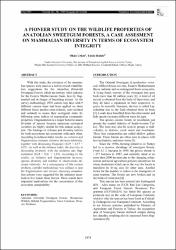| dc.contributor.author | Ürker, Okan | |
| dc.contributor.author | İlemin, Yasin | |
| dc.date.accessioned | 2020-11-20T14:43:27Z | |
| dc.date.available | 2020-11-20T14:43:27Z | |
| dc.date.issued | 2019 | |
| dc.identifier.issn | 1018-4619 | |
| dc.identifier.issn | 1610-2304 | |
| dc.identifier.uri | https://hdl.handle.net/20.500.12809/1190 | |
| dc.description | WOS: 000477688700055 | en_US |
| dc.description.abstract | With this study, the existence of the mammalian species were used as a tool to reveal rehabilitation suggestions for the Anatolian (Oriental) Sweetgum Forests which are tertiary relict endemic for the Eastern Mediterranean Basin, heavily fragmented and in danger of becoming extinct. As the survey methodology; 2976 camera trap days with 9 different camera traps had been applied on three different forest patches (non-isolated, semi-isolated and isolated) to assess their ecological status by following some indices of mammalian community properties. Fragmentation is a major factor to assess diversity of species because numerous ecological variables are highly similar for this unique ecosystem. The findings of richness and diversity indices for both ecosystems are consistent with each other. According to richness index results; as isolation and fragmentation increase, richness decrease relatively, together with decreasing frequency (0,29 < 0,57 < 0,87). As well as the richness index, the diversity is decreasing inversely with the isolation and fragmentation (0,24 < 0.81 < 1.03). According to the results; as isolation and fragmentation increase, species diversity and number of observations decrease relatively. As a consequence of this current problem, corridor methodology was utilised to stop the fragmentation and various necessary conservation actions were suggested for the indicator mammals to live inside those forests. These results have important implications for the conservation of this ecosystem sustainability. | en_US |
| dc.description.sponsorship | Rufford Foundation [16444-2] | en_US |
| dc.description.sponsorship | We thank Kemal Parlar for the proofreading, Alp Giray for his assistance in the field, and Tarkan Yorulmaz for his helps on identification of the mammalian species. The present study was financially supported by The Rufford Foundation (RF, project no: 16444-2). The authors declare that they do not have any conflict of interest regarding this paper. | en_US |
| dc.item-language.iso | eng | en_US |
| dc.publisher | Parlar Scientific Publications (P S P) | en_US |
| dc.item-rights | info:eu-repo/semantics/openAccess | en_US |
| dc.subject | Anatolian (Oriental) Sweetgum Forests | en_US |
| dc.subject | Mammalian Wildlife | en_US |
| dc.subject | Habitat Fragmentation | en_US |
| dc.subject | Forest Corridors | en_US |
| dc.subject | Diversity | en_US |
| dc.subject | Richness | en_US |
| dc.title | A PIONEER STUDY ON THE WILDLIFE PROPERTIES OF ANATOLIAN SWEETGUM FORESTS, A CASE ASSESMENT ON MAMMALIAN DIVERSITY IN TERMS OF ECOSYSTEM INTEGRITY | en_US |
| dc.item-type | article | en_US |
| dc.contributor.department | MÜ, Fethiye Ali Sıtkı Mefharet Koçman Meslek Yüksekokulu, Çevre Koruma Teknolojileri Bölümü | en_US |
| dc.contributor.institutionauthor | İlemin, Yasin | |
| dc.identifier.volume | 28 | en_US |
| dc.identifier.issue | 7 | en_US |
| dc.identifier.startpage | 5474 | en_US |
| dc.identifier.endpage | 5480 | en_US |
| dc.relation.journal | Fresenius Environmental Bulletin | en_US |
| dc.relation.publicationcategory | Makale - Uluslararası Hakemli Dergi - Kurum Öğretim Elemanı | en_US |


















